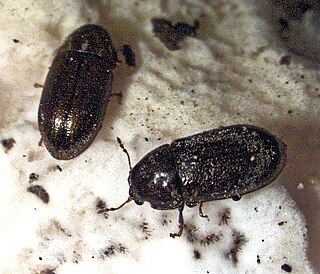
Calotes is a genus of lizards in the draconine clade of the family Agamidae. The genus contains 28 species. Some species are known as forest lizards, others as "bloodsuckers" due to their red heads, and yet others as garden lizards.

The green pheasant, also known as Japanese green pheasant, is an omnivorous bird native to the Japanese archipelago, to which it is endemic. Some taxonomic authorities still consider it a subspecies of the common pheasant, Phasianus colchicus. It is the national bird of Japan.

Tinea versicolor is a condition characterized by a skin eruption on the trunk and proximal extremities. The majority of tinea versicolor is caused by the fungus Malassezia globosa, although Malassezia furfur is responsible for a small number of cases. These yeasts are normally found on the human skin and become troublesome only under certain circumstances, such as a warm and humid environment, although the exact conditions that cause initiation of the disease process are poorly understood.

Hylidae is a wide-ranging family of frogs commonly referred to as "tree frogs and their allies". However, the hylids include a diversity of frog species, many of which do not live in trees, but are terrestrial or semiaquatic.

The silver teal or versicolor teal is a species of dabbling duck in the genus Spatula. It breeds in South America.

Hyla is a genus of frogs in the tree frog family Hylidae. As traditionally defined, it was a wastebasket genus with more than 300 species found in Europe, Asia, Africa, and across the Americas. After a major revision of the family most of these have been moved to other genera so that Hyla now only contains 17 extant (living) species from Europe, northern Africa and Asia. The earliest known fossil member of this genus is †Hyla swanstoni from the Eocene of Saskatchewan, Canada, but its designation to Hyla happened before the major revision, meaning that its position needs confirmation.

Trametes versicolor – also known as Coriolus versicolor and Polyporus versicolor – is a common polypore mushroom found throughout the world. Meaning 'of several colors', versicolor reliably describes this fungus that displays different colors. For example, because its shape and multiple colors are similar to those of a wild turkey, T. versicolor is commonly called turkey tail. A similar looking mushroom, commonly called false turkey tail, which is from a different order, may sometimes be confused with the turkey tail mushroom due to appearance. Another lookalike is the multicolor gill polypore.

Panulirus versicolor is a species of spiny lobster that lives in tropical reefs in the Indo-Pacific. Other names include painted rock lobster, common rock lobster, bamboo lobster, blue lobster, and blue spiny lobster. P. versicolor is one of the three most common varieties of spiny lobster in Sri Lanka, alongside Panulirus homarus and Panulirus ornatus.

The Vietnam mouse-deer, also known as the silver-backed chevrotain, is an even-toed ungulate in the family Tragulidae known only from Vietnam. It was first described in 1910 by British zoologist Oldfield Thomas, who procured four specimens from Nha Trang in Annam. Little is known about its distribution and ecology. After 1910, the Vietnam mouse-deer was reported next in 1990 near Dak Rong and Buon Luoi in the Gia Lai Province. With increasing hunting pressure, habitat loss due to deforestation and no more reports of the species in the wild, the mouse-deer was feared to have gone extinct. The IUCN listed the species as Data Deficient in 2008. In 2019, a study confirmed the presence of the Vietnam mouse-deer in dry low-lying forests of southern Vietnam with camera trap evidence. The mouse-deer is characterised by a rough coat with a strange double-tone coloration unseen in other chevrotains; the front part of the body is reddish brown and contrasts strongly with the greyish posterior. It has big reddish brown ears, white and dark reddish brown marks on the throat.
Diplotoxa versicolor is a species of grass fly in the family Chloropidae.
Neoxenus versicolor is a species of fungus weevil in the beetle family Anthribidae. It is found in Central America and North America.
Neoxenus is a genus of fungus weevils in the beetle family Anthribidae. There are about six described species in Neoxenus.
Climacia is a genus of spongillaflies in the family Sisyridae. There are more than 20 described species in Climacia.

Cis fuscipes, the minute tree-fungus beetle, is a species of minute tree-fungus beetle in the family Ciidae. It is found in Australia, the Caribbean, North America, Oceania, and Europe.
Cis vitulus is a species of minute tree-fungus beetle in the family Ciidae. It is found in North America.
Cis hirsutus is a species of minute tree-fungus beetle in the family Ciidae. It is found in the Caribbean Sea and North America.
Cis rotundulus is a species of minute tree-fungus beetle in the family Ciidae. It is found in North America.
Cis creberrimus is a species of minute tree-fungus beetle in the family Ciidae. It is found in the Caribbean Sea, Central America, North America, and South America.
Cis levettei is a species of minute tree-fungus beetle in the family Ciidae. It is found in North America.
Cis quadridentatus is a species of minute tree-fungus beetle in the family Ciidae. It is found in North America.









